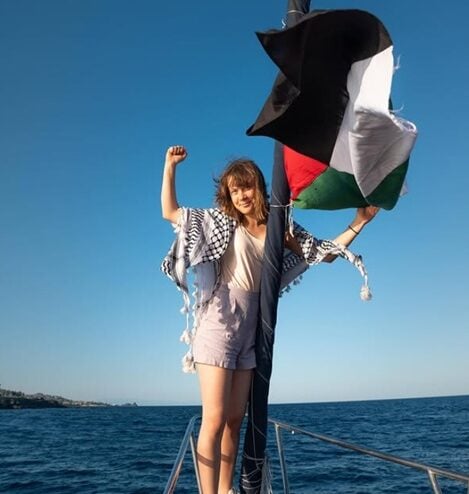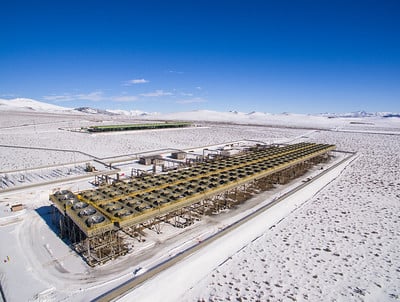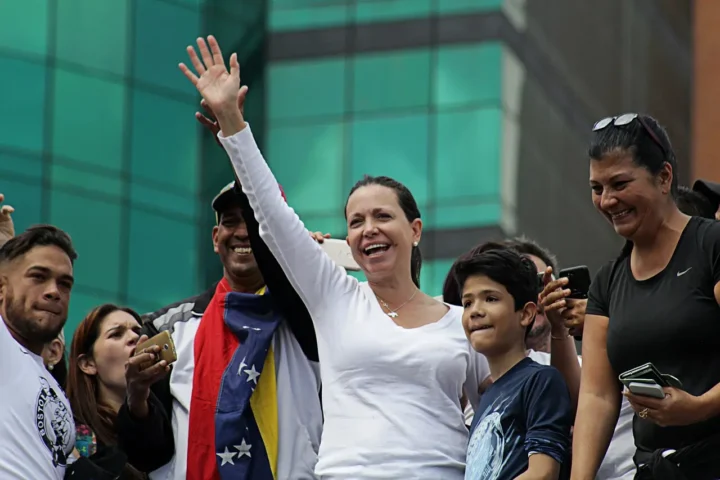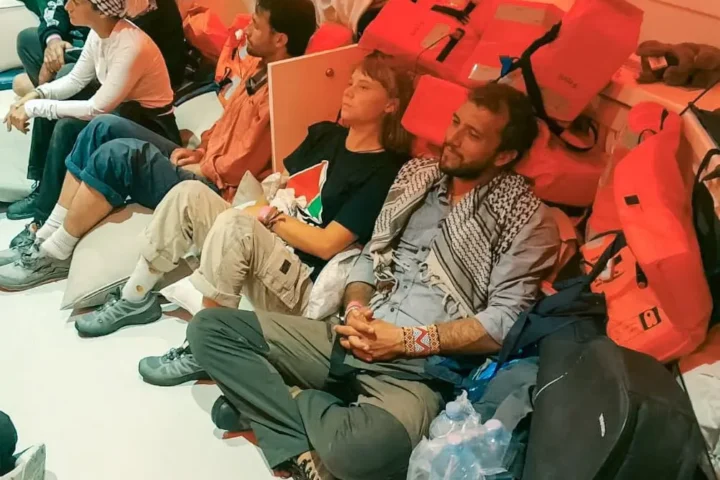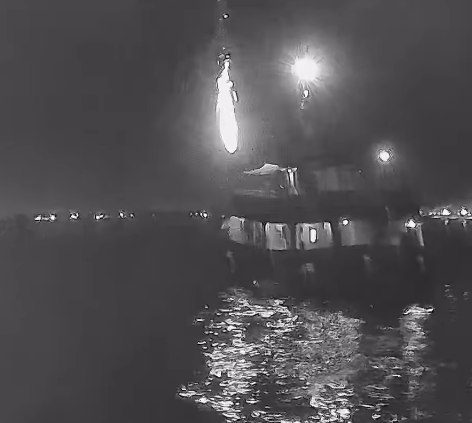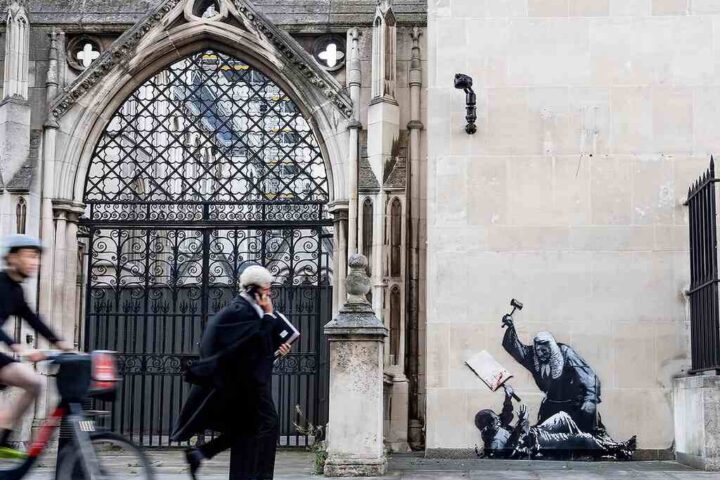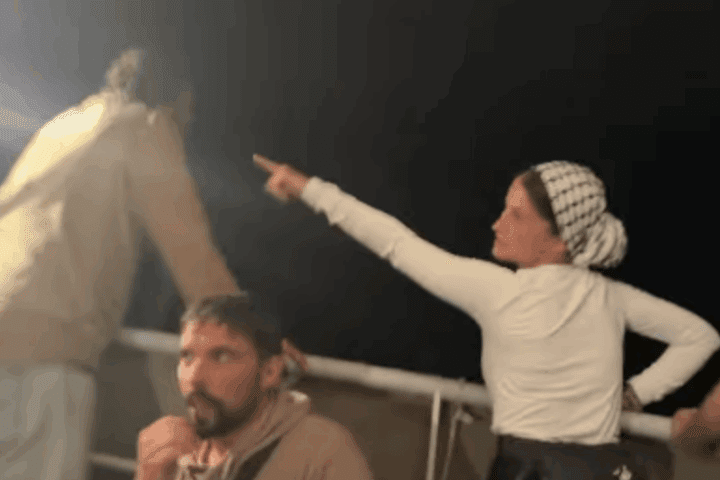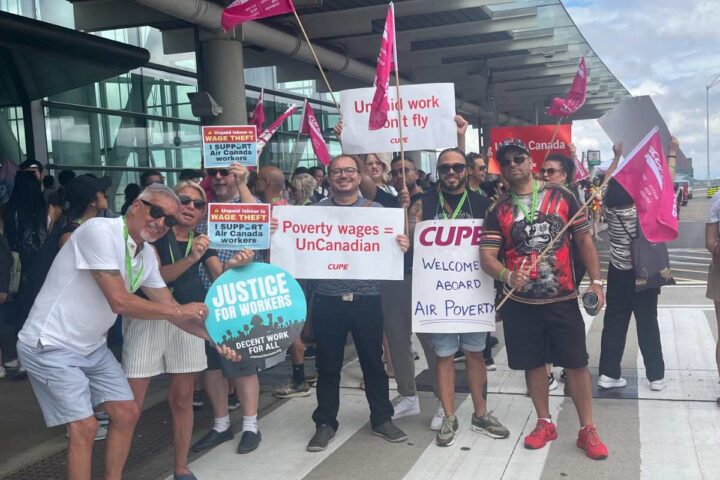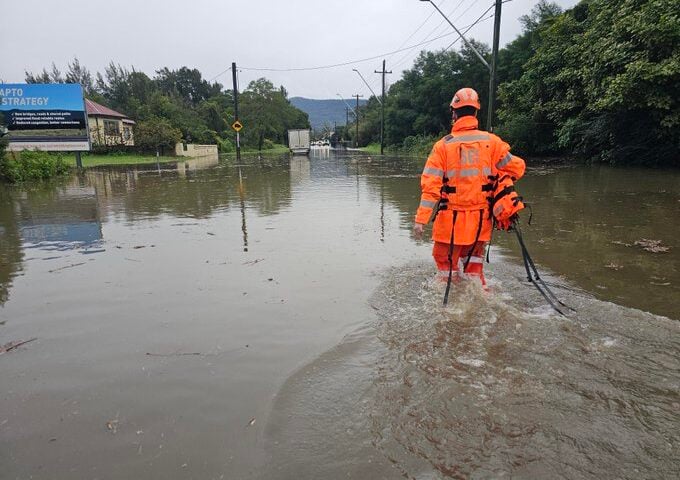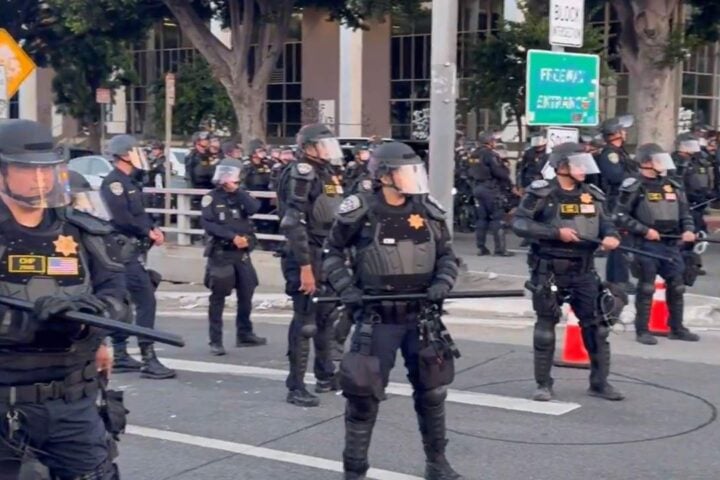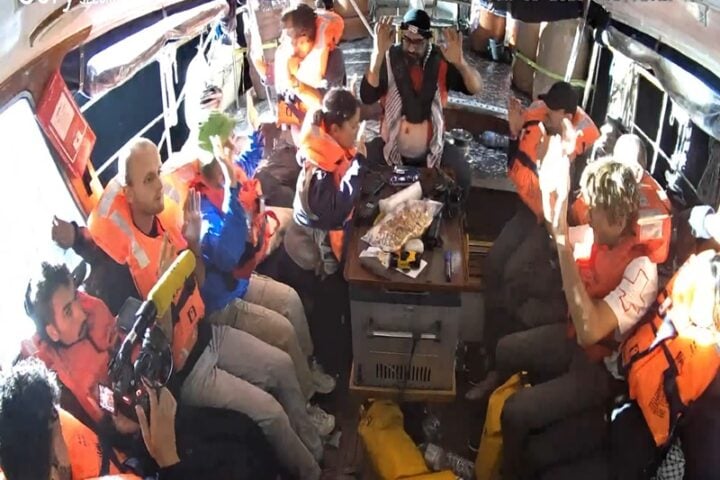The Mediterranean Sea stretches endlessly ahead as the Madleen cuts through waters that have become a flashpoint for international humanitarian law. Named after Gaza’s first female fisherwoman, this 12-person vessel carries more than humanitarian supplies – it carries the hopes of activists challenging one of the world’s most contested naval blockades.
A Ship Named for Resilience
On June 1, 2025, at precisely 4:00 PM Central European Summer Time, the Madleen departed from Catania, Sicily’s bustling port. The vessel, operated by the Freedom Flotilla Coalition (FFC), set course for Gaza carrying humanitarian aid and 12 international activists, including Swedish climate activist Greta Thunberg, Game of Thrones actor Liam Cunningham, and French Member of European Parliament Rima Hassan.
The complete crew consists of: Greta Thunberg (Sweden), Liam Cunningham (Ireland), Rima Hassan (France), Thiago Ávila (Brazil), Yasemin Acar (Germany), Baptiste André (France), Omar Fayad (France), Pascal Maurieras (France), Yanis M’Hamdi (France), Suyab Ordu (Türkiye), Sergio Toribio (Spain), Mark Van Rennes (Netherlands), and Reva Seifert Viard (France).
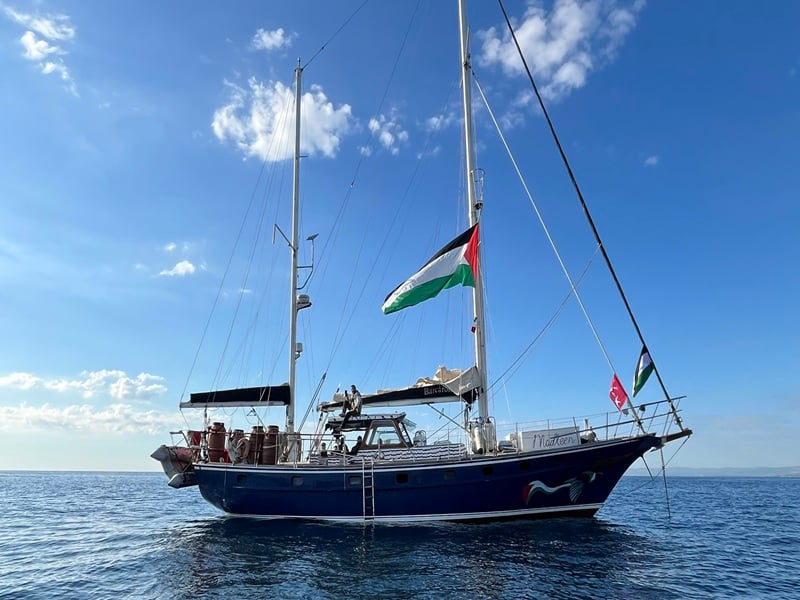
The ship’s name honors Madleen al-Hamra, Gaza’s first and only fisherwoman, who took over her family’s fishing business in 2009 after her father was wounded in an Israeli attack. The symbolism runs deeper than mere tribute – it represents a fishing industry that has withered under restrictions that have reduced Gaza’s accessible fishing zone from 20 nautical miles before 2007 to just 3-6 nautical miles today.
The cargo manifest tells the story of Gaza’s acute needs: medical supplies, flour, rice, baby formula, nappies, women’s sanitary products, water desalination kits, crutches and children’s prosthetics. Each item on this list represents lives hanging in the balance.
Gaza’s Humanitarian Crisis by the Numbers
The statistics paint a devastating picture. According to UN reports, 66,000 children are suffering from severe malnutrition in Gaza as of May 2025. Nearly 71,000 children under the age of five are expected to be acutely malnourished over the next 11 months, with 14,100 cases expected to be severe.
Since an aid blockade began on March 2, 2025, 57 children have reportedly died from malnutrition effects according to Gaza’s Ministry of Health. Food prices have skyrocketed, with a 25-kilogram sack of wheat flour now costing between $235 and $520 – representing a 3,000 percent price increase since February.
For the projection period from May 11 to September 30, 2025, the entire Gaza Strip faces Crisis-level food insecurity, with 924,000 people in Emergency phase (IPC Phase 4) and 244,000 people facing catastrophic levels of acute food insecurity (IPC Phase 5).
The Journey and Its Perils
The Madleen’s planned seven-day journey covers approximately 2,000 kilometers, with an expected arrival on June 7. But this voyage follows a troubling precedent. Just one month earlier, another FFC vessel, the Conscience, was struck by two drones in international waters off Malta on May 2, 2025. As Greta Thunberg stated from aboard the Madleen, “All evidence strongly suggests that it was Israel who did it”.
Greek Coast Guard Heron drones have been spotted circling the vessel approximately 68 kilometers outside Greek territorial waters. The surveillance is part of what observers call the “3+1 framework” – a security cooperation agreement between Greece, Cyprus, Israel, and the United States for Mediterranean monitoring.
The activists remain committed to non-violence. As the Freedom Flotilla Coalition emphasizes, “All volunteers and crew aboard Madleen are trained in nonviolence. They are sailing unarmed”, united by the shared belief that Palestinians deserve the same rights, freedom, and dignity as all people.
Voices from the Vessel
From international waters, Greta Thunberg spoke to reporters about the mission’s deeper meaning. “When our governments are failing us… then it falls on us to step up and be the adults in the room,” she told Middle East Eye.
“We are doing this because, no matter what odds we are against, we have to keep trying,” Thunberg said, breaking into tears during her departure speech. “Because the moment we stop trying is when we lose our humanity”.
French MEP Rima Hassan, who has been barred from entering Israel due to her opposition to the Gaza assault, offered her perspective: “We are seeing a systematic starvation of 2 million people. The world cannot be silent bystanders. Every single one of us has a moral obligation to do everything we can to fight for a free Palestine”.
Actor Liam Cunningham, speaking at the departure ceremony, characterized the mission in stark terms: “The reason I’m here as far as I’m concerned the heart and soul of humanity is in Gaza for me this attack this genocide is not just on Palestinians it is on the whole human race”.
Israel’s Response and International Reactions
Israeli officials maintain that the naval blockade, in place since 2007, is a necessary security measure to prevent weapons smuggling to Hamas. IDF spokesperson Brig.-Gen. Effie Defrin has indicated they are prepared to intercept the vessel, stating authorities will “act accordingly”.
The threats extend beyond official channels. U.S. Senator Lindsey Graham wrote on X: “Hope Greta and her friends can swim!” When asked about this threat, Thunberg responded simply: “We can swim very well”.
The Gaza Freedom Flotilla has been shadowed by at least one military helicopter and multiple drones since departure. Activists have been sending regular alerts with their coordinates for safety and accountability.
The Legal Framework Behind Naval Blockades
The legality of naval blockades operates within a complex framework of international maritime law. The San Remo Manual on International Law Applicable to Armed Conflicts at Sea, adopted in 1994, provides the primary legal framework for naval blockades during armed conflicts.
Under the San Remo Manual, a blockade must be declared and announced, effective, non-discriminatory, and must permit the passage of humanitarian assistance to civilian populations. However, the blockading party may decide where, when, and through which port humanitarian assistance should reach the coast, and may require neutral organization oversight of distribution.
The 2011 Palmer Report, investigating the 2010 Mavi Marmara incident, concluded that “Israel faces a real threat to its security from militant groups in Gaza. The naval blockade was imposed as a legitimate security measure in order to prevent weapons from entering Gaza by sea and its implementation complied with the requirements of international law”.
However, UN independent experts criticized the Palmer Report’s conclusion, stating that “the Palmer Report does not recognize the naval blockade as an integral part of Israel’s closure policy towards Gaza which has a disproportionate impact on the human rights of civilians”. They emphasized that “1.6 million Palestinian women, men and children are deprived of their fundamental human rights and subjected to collective punishment, in flagrant contravention of international human rights and humanitarian law”.
Similar Posts
Historical Context: From Mavi Marmara to Conscience
The current mission operates against a backdrop of previous confrontations. In 2010, Israeli commandos stormed the Mavi Marmara in international waters, killing nine people with a tenth dying after four years in a coma. While the Palmer Report found the blockade legal, it concluded that IDF commandos used “excessive and unreasonable” force during the raid.
The 2025 attack on the Conscience vessel represents an escalation. The Freedom Flotilla Coalition reported that the attack occurred at 12:23 PM local time on May 2, blowing a hole in the vessel and setting the engine ablaze. Unlike the 2010 incident involving boarding and confrontation, this was a drone strike on an unarmed civilian vessel in international waters.
Gaza’s Fishing Industry: A Symbol of Restriction
The choice to name the vessel after Gaza’s pioneering fisherwoman carries profound significance. Before 2007, Gaza’s fishing industry operated within a 20-nautical-mile zone under the Oslo Accords. Today, approximately 35 percent of Gaza’s arable land and 85 percent of its fishing waters are totally or partially inaccessible due to Israeli military measures.
This restriction has devastated livelihoods. Before 2007, over 10,000 fishers were registered in Gaza supporting approximately 18,000 people. By 2025, only about 3,600 fishers remain active, with average household income from fishing declining by 50-70 percent since 2007.
Environmental and Water Crisis
Gaza faces multiple interconnected crises. According to UN Office for the Coordination of Humanitarian Affairs (OCHA) data from 2011 that remains widely cited in current reporting, approximately 35 percent of Gaza’s arable land and 85 percent of its fishing waters are totally or partially inaccessible due to Israeli military measures. Current reports indicate 90-95 percent of Gaza’s water is polluted and unfit for human consumption, with large quantities of untreated sewage released into the environment daily. The water desalination kits aboard the Madleen address this critical need.
The environmental dimension connects to Greta Thunberg’s climate activism. “We cannot have climate justice without social justice,” she explained during her Democracy Now interview. “The reason why I am a climate activist is not because I want to protect trees, I’m a climate activist because I care about human and planetary well-being and those are extremely interlinked”.
What Happens Next
Israeli authorities have implemented rules stating that intercepted civilian vessels will be warned twice before force is used; non-violent crews can be detained up to 48 hours before deportation. Should the Madleen be intercepted and taken to Ashdod, activists would face processing by the Israeli Immigration Authority and likely deportation within 48 hours.
The mission occurs alongside broader solidarity efforts. A “Global March to Gaza” is planned for mid-June, with protesters attempting to reach the Rafah crossing from Egypt. As activist Thiago Ávila explained, “We are breaking the siege of Gaza by sea, but that’s part of a broader strategy of mobilizations that will also attempt to break the siege by land”.
The Human Cost
Behind the legal debates and geopolitical maneuvering lie individual stories of suffering. Children continue to die from malnutrition-related causes, according to Gaza’s Ministry of Health. Medical experts warn that childhood malnutrition creates lasting damage: “Children who experience severe malnutrition may never reach their full cognitive or physical potential, according to multiple studies that have tracked survivors of past food shortages”.

As the Madleen continues its journey toward Gaza’s shores, it carries more than humanitarian supplies. It carries questions about international law, moral obligation, and the rights of civilians caught in conflict zones. Whether the vessel reaches its destination or faces interception, its voyage has already placed global attention on Gaza’s humanitarian crisis and the ongoing debate over the naval blockade’s legitimacy.
The Mediterranean waters ahead hold the answers to whether international solidarity can pierce the barriers that have kept essential aid from reaching those who need it most. For 2.1 million people in Gaza, the outcome of this mission represents far more than a symbolic gesture – it represents hope for survival.
The Madleen’s location can be tracked in real-time through the Freedom Flotilla Coalition’s live tracker. As of publication, the vessel remained on course for its planned June 7 arrival at Gaza’s shores.
